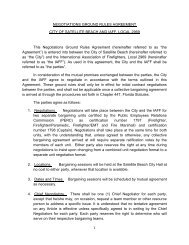Supporting Documents (Data and Analysis) - Satellite Beach
Supporting Documents (Data and Analysis) - Satellite Beach
Supporting Documents (Data and Analysis) - Satellite Beach
Create successful ePaper yourself
Turn your PDF publications into a flip-book with our unique Google optimized e-Paper software.
The term “affordable housing” is simply the relationship between the income of consumers<br />
(buyers <strong>and</strong> renters) <strong>and</strong> the cost (price) of the product (houses <strong>and</strong> apartments). Significant<br />
changes in either of these two variables can “produce” or “lose” affordable housing. Affordable<br />
housing is typically defined as “housing which costs 30% or less of a family’s gross income.”<br />
Households are typically defined as very low, low, <strong>and</strong> moderate income based on thresholds tied<br />
to the median income of a county or metropolitan statistical area. These thresholds are 50, 80,<br />
<strong>and</strong> 120 percent of median income, respectively. Workers in households earning between 80<br />
percent <strong>and</strong> 120 percent of area median income (AMI), HUD’s moderate income level, fill the<br />
majority of jobs in nearly every sector of the economy, especially in services <strong>and</strong> retail trade.<br />
These households are known as the “workforce.” Workforce households are diverse in character<br />
<strong>and</strong> composition, <strong>and</strong> may include single persons, with or without children, or married persons,<br />
one (or occasionally both) with a workforce job. Moreover, workforce households often serve as<br />
essential frontline servers in the economy. Examples of workforce jobs can include a police<br />
officer, construction worker, teacher, nurse, retail salesperson, <strong>and</strong> waiter. While many of these<br />
households may not fall within HUD’s target population, these are the workers who are finding it<br />
increasingly more difficult to find “affordable housing.” In the past, the efforts were concentrated<br />
on low <strong>and</strong> very low income residents but the issue of affordable housing has recently exp<strong>and</strong>ed<br />
to include the moderate income workforce population.<br />
While roughly half of Brevard County’s ten largest employers have a large percentage of<br />
employees that would exceed the annual income of those defined as “workforce” employees,<br />
there are still a great many that would make the annual income of the workforce population.<br />
Table 3-20 below shows the average annual income for several occupations that are part of the<br />
workforce population <strong>and</strong> the maximum mortgage an individual in that occupation would be able<br />
to afford based on income.<br />
In order to pay for a home at the median cost of $310,000 or even at $262,000 many <strong>Satellite</strong><br />
<strong>Beach</strong> households would become cost-burdened. "Cost-burdened" households pay more than<br />
30% of income for rent or mortgage costs. In 2005, 1011 <strong>Satellite</strong> <strong>Beach</strong> households (22%) paid<br />
more than 30% of their income for housing. By comparison, 29% of households statewide are<br />
cost-burdened. In addition, 442 households (10%) in <strong>Satellite</strong> <strong>Beach</strong> pay more than 50% of their<br />
income for housing.<br />
<strong>Satellite</strong> <strong>Beach</strong> is not alone in its quest to provide more affordable housing to its residents.<br />
Communities throughout the State of Florida are re-analyzing their planning documents to ensure<br />
that appropriate measures are being taken to provide attainable housing. Local governments are<br />
searching for innovative ways, other than relying on Federal <strong>and</strong> State programs, to meet the<br />
need for affordable housing.<br />
Affordable housing is an issue that affects all segments of the local economy. The high cost of<br />
housing forces lower wage earners to live in outlying areas where housing costs are cheaper.<br />
This, in turn, increases travel costs for these workers as well as increasing government costs<br />
through the increased dem<strong>and</strong> for services in areas where such services may not be readily<br />
available or able to be provided efficiently. This growth pattern also increases roadway<br />
Housing Element<br />
<strong>Data</strong> <strong>and</strong> <strong>Analysis</strong> 3-5
















